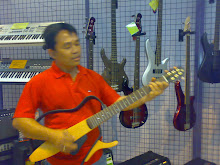My recent trip to China last August 6 – 10 took me to four (4) major cities and three (3) provinces from Southern to Central Eastern regions of Mainland China. With Xiamen in the Fujian province as my starting take-off point, I visited the following (1) Guangdong Hanjiang Steel Plate Co. Ltd. located in Chaozhou City, Guangdong province south of Xiamen, (2) Sino Coalition Ningbo Steel Production Co. Ltd. in Ningbo City and (3) Zhejiang Southeast Metalsheet Co. Ltd. in Hangzhou City, both in the central eastern area of Zhejiang province, not far from Shanghai.
The objective of my trip was to conduct technical meetings and evaluate the potential of these three (3) companies as suppliers of G.I. products in terms of their technical capabilities to meet specifications.
This is my 3rd visit to China. The first 2 visits though took me only to Xiamen. And everytime I set foot in this beautiful city, I'm always met with something new about the place.
When we first visited Xiamen in 6 years ago, in September 2006, construction was in frenzy; both within and outside the city. Steel demand was at its peak as China was preparing for the 2008 Beijing Olympics. There was only one SM Mall then, the first SM venture in China. When I came back last year, everything seemed in place. Buildings were completed and those construction outside the city were now converted to vibrant communities. There were now 2 SM malls. The first Robinson's Galleria was also completed with another one under construction. There was one notable sight though that did not escape me; the city became more green with full grown tress even in downtown Xiamen.
Taken from my hotel window, Swan Hotel
Aug. 06, 2012
I arrived Xiamen by PAL direct from Manila (2hrs. and 20 min.) at a little past 10 in the morning and was met by our Chinese traders who arranged my trip.. We drove directly to Guangdong Hanjiang Steel Plate Co. Ltd. It was raining all week in Manila when I left and so sunny Xiamen was a welcome relief.
It was a 3 ½ hour ride (30 min. for lunch stop over in a roadside rest and eating area) of long stretches of expressway, passing by three tunnels (cut from mountains) as long as 2 kms., bridges and viaducts up to 8 kms. long. It was indeed a rural setting and only a few cars and trucks joined us in our trip. This is a glimpse of how China built its transportation infrastructure, interchange linkup on all communities to the highway. Road signs are everywhere in Chinese and English, just like in the US interstates, directional signs, safety signs, distances, speed limits per lane, etc. I could only wish those managing our expressways back home could at least learn some basic lessons on road management. This is the least we, or I who takes the South Luzon expressway everyday, could ask. After all, we pay high toll rates.
We finally reached our destination at around 2:30pm. That 3 hour actual travel time running at the average speed of 120 kph (reaching 140 kph), the distance we covered must be around 350 kms, almost a back and forth distance from Calamba to La Union.
We spent around 2 hours in the plant covering our technical meeting and brief plant tour. Immediately after that , we drove back to Xiamen, arriving there at around 7:30 p.m. We checked in at Swan Hotel, a spanky hotel with a scenic view along a river and a lake. At a private dinner later in the hotel, we were joined by a major principal of the trading firm. He is a Taiwanese businessman who used to work in major steel companies in Taiwan, BHP and Ton Yi. We talked on developments in the steel industry, local and international and he went on retracing his days at BHP and Ton Yi. Quite proficient in english, he has now shifted to agriculture and put up a “mushroom” plantation and processing plant which
he hopes to export soon. “Mushroom he says is better than steel”.
Talking about the Taiwan connection, many companies, big and small in Xiamen and Fujian province for that matter, are owned by Taiwanese businessmen. Taiwan food products are also sold in many grocery stores. In the past, there were no direct flights from Taiwan to mainland China. Taiwanese who visit Mainland China have to make make a transient stopover in Hongkong before proceeding to Mainland. Now, there are many direct flights from Kaoshioung to Xiamen, Hangzhou, and I suppose Shanghai and Beijing too.
During the day, you could sense the freshness of the city. It is clean and green with trees and plants everywhere at the center and at the side parking streets. There is practically no open space in the city as open spaces are planted with plants and trees. That is also true even outside the city. The long expressways were filled with trees and plants not only on both sides but also at the center separating both directions of the highway. No wonder, it is considered as the most livable city in China.










1 comment:
I love your blog, don't find many that are so clear, it is nice to see that someone really Understands. I really enjoyed reading this. Thanks
china steel making market
Post a Comment